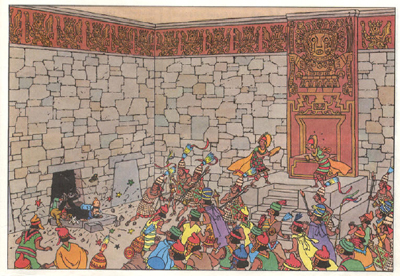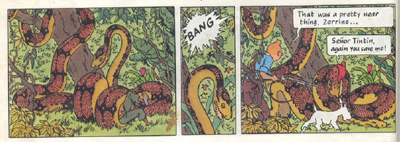In the lead-up to the release of The Adventures of Tintin: The Secret of the Unicorn, I’m going to be taking a look at Hergé’s celebrated comic book character, from his humble beginnings through to the incomplete post-modern finale. I hope you enjoy the ride.
I have to admit to really liking the two-part Seven Crystal Balls and Prisoners of the Sun adventure, to the extent that I’m actually eagerly anticipating Peter Jackson’s adaptation that may never materialise. The two-parter really just takes the best aspects of Hergé’s Tintin mythos, brewing up a pop culture stew that can be served as a mystery story or an adventure into a mystical and unknown world. The idea of discovering a long-lost tribe of ancient Inca is certainly an appealing one, and would make for a gripping turn-of-the-century adventure. Using that premise as a starting point, Hergé leads us and Tintin in the heart of Amazon, filled with excitement and danger and mystery.
There’s a rather similar theme to both Prisoners of the Sun and Red Rackham’s Treasure. Both adventures seem to celebrate genres that have fallen by the wayside in the mid-twentieth century. While Red Rackham’s Treasure was a fantasy about digging up long-forgotten pirate treasure, Prisoners of the Sun involves the discovery of an entire civilisation that the outside world is completely unaware of. It’s fitting that the story ends with Tintin’s promise to keep their secret, as you can sense the desire to preserve that isolation and beauty, untouched by the outside world. Both stories feature rather common story-telling devices that would have been frequently used in the trashy fiction of the nineteenth century, but had been all but ignored by most modern writers. It’s clear the affection Hergé holds for these old plots, as one can determine from the energy he devotes to bringing them to life.
It’s almost a little strange that Steven Spielberg, who draws a lot of parallels between Tintin and Indiana Jones, should favour The Secret of the Unicorn over this tale. While The Secret of the Unicorn and Red Rackham’s Treasure do have quite a few archeological themes and draw on rich ancient history, I fond myself thinking more of Indiana Jones here, especially with the mystical powers explicitly linked to ancient talismans as in Raiders of the Lost Ark and Indiana Jones and the Last Crusade, and with a long-forgotten cult secreted away practicing human sacrifice like in Indiana Jones and the Temple of Doom. For me, the links just feel a lot stronger, and I do think this adventure is just a bit more pulpy than those that surround it.
While we’re on the topic, I do find it interesting that Hergé is so accepting of ancient Incan mysticism here. In Cigars of the Pharaoh, Hergé went out of his way to demonstrate the ancient Egyptian curse was being fostered by an evil drugs cartel, and that everything had a purely rational explanation. Here, however, there is no real rational explanation for the mysterious deep sleep the explorers were sent into. Rather than being given a cure for them or anything like that, Tintin simply watches the Incan chief throw the dolls into the fire, instantly freeing his victims, half the world away. There’s no logical way to link those two events without accepting some form of mystical explanation. “Witch craft!” Tintin exclaims, “I can’t believe it!”
It’s a nice touch, and a sign that Hergé is moving away from a position of hard skepticism in crafting his stories. It’s very hard to claim, for example, that the aliens in Flight 714 destroy the “realism” of the series when you consider that Incan curses appear to be a verifiable fact in Tintin’s universe. Part of what I liked about The Seven Crystal Balls was the way that it did present this sort of conflict between the rational and irrational possibilities, and it’s nice that Hergé doesn’t have the story embrace one at the expense of the other. It lends the story a genuinely old-fashioned feel, and one that I think suits it.
It helps that the story is driven by a very effective motivation for Tintin and Haddock. They aren’t searching for treasure, or even for knowledge itself. They are attempting to rescue a dear friend who is lost and alone on the other side of the planet. It’s a powerful emotional story point, and I think it adds a bit more depth than the pair’s usual adventures. It’s so effective that Hergé would effectively return to the plot point in Tintin in Tibet, a story that made much better use of the emotional torque. Still, it does serve to add some depth here.
Now on to the tricky part in discussing the adventure, the portrayal of the native population. There’s no denying that Hergé has come a long way since his portrayal of local Africans in Tintin in the Congo, and even Native Americans in Tintin in America or the Japanese in The Blue Lotus. However, I did feel a bit uneasy with some of the rather unfortunate implications of the text. For one, it seems that every Peruvian Indian in the story is involved, or at least aware, of the practice of abducting foreigners for human sacrifice. In fact, Tintin is able to deduce that the quarantine of the ship holding Calculus is a set-up based solely on the ethnicity of the doctor. “Tell me, isn’t that doctor an Indian!” he observes. When asked why, he remarks, “Oh, no reason.” But you can practically see the wheels turning in his head.
Indeed, it seems like every Indian in the story is a slave to local superstition, and too terrified to do the right thing, lest they be sacrificed. When a train conductor refuses to commit what is essentially an act of murder, he is brought into line with a none-too-subtle threat, “It is his order – and you know what happens to those who disobey him…” Sure, two Indian characters in the story are swayed by Tintin’s rescue of an Indian orange seller from two foreign bullies, but it still seems a little unfortunate to believe that virtually every Indian in the country is aware of – and in the power of – this ancient bunch of human-sacrificing Incas in the forest. Never mind the seeming racist attitude that the tribe appears to adopt towards “those vile foreigners who we hate.”
However, what makes all this truly strange is the fact that Hergé seems to believe the continued existence of these kill-happy Incans (who, it appears, have also forgotten everything their ancestors knew about eclipses) is something to be lauded. Hergé seems delighted to unveil “the treasure of the Incas, for which the Spanish Conquerers searched in vain for so long!” I can understand why preserving some aspect of an ancient civilisation might be an appealing notion, particularly one wiped out in so cruel a manner, but Hergé does little to capture any aspects of Incan culture beyond human sacrifice and a conspiracy of silence. While we might hope that some ancient civilisation could have survived an encounter with Spanish Conquistadors, we might also hope that they had moved beyond human sacrifice. It’s hard to laud any society built on such a foundation of fear, especially when it enforces such a harsh code of silence, “Vengeance of Inca terrible when Indian tell white man what white man must not know.”
So it feels slightly surreal to see Tintin and his friends wander off into the sunset with smiles on their faces. If there hadn’t been a solar eclipse (and the Incas hadn’t forgotten stuff they knew centuries ago), all three characters would be dead. There’s nothing to stop the Incas from abducting and sacrificing more foreigners who have accidentally offended them, and Tintin’s vow of secrecy really prevents him from warning anybody about potentially upsetting the native populations. Of course, you could argue that the story needs these sorts of plot points (the code of secrecy and the human sacrifice) in order to work as a pulpy old-fashioned adventure yarn, and I accept that. Similarly, I do respect that Hergé didn’t seek to vilify a civilisation that had been all but exterminated by Europeans. Still, the portrayal of the Incas does make me feel just a bit uneasy.
Still, I think that – if you can look past the somewhat unfortunate questions raised by Hergé’s handling of the Peruvian Incas – Prisoners of the Sun makes for a rather wonderful little adventure, with a nice pulpy feel. The series is really in its stride at this point of the game, and there are some great stories still ahead.
Filed under: Comics | Tagged: Adventures of Tintin, Captain Haddock, edgar wright, Hergé, indiana jones, Jamie Bell, peter jackson, Prisoner of the Sun, prisoners of the sun, Red Rackham's Treasure, steven spielberg, the adventures of tintin: prisoners of the sun, The Adventures of Tintin: Secret of the Unicorn, the adventures of tintin: the prisoners of the sun, the prisoners of the sun, tintin and the prisoners of the sun, Tintin in the Congo |

























Leave a comment